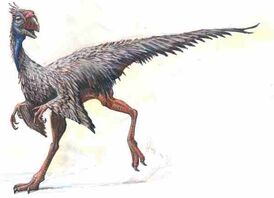
Caudipteryx (which means "tail feather") is a genus of peacock-sized theropod dinosaurs that lived in the Aptian age of the early Cretaceous Period (about 124.6 million years ago). They were feathered and remarkably birdlike in their overall appearance.
The hands of Caudipteryx supported symmetrical, pennaceous feathers that had vanes and barbs, and that measured between 15–20 centimeters long (6–8 inches). These primary feathers were arranged in a wing-like fan along the second finger.No fossil of Caudipteryx preserves any secondary feathers attached to the forearms, as found in Archaeopteryx and modern birds.Either these arm feathers are not preserved, or they were not present on Caudipteryx in life. An additional fan of feathers existed on its short tail. The shortness and symmetry of the feathers, and the shortness of the arms relative to the body size, indicate that Caudipteryx could not fly.The body was covered in a coat of short, simple, down-like feathers.It is thought to have been an omnivore.
The discovery of Caudipteryx led to many intensive studies on and debate over the relationship of birds and dinosaurs. The possible positions in the debate can be summarized as follows: Caudipteryx is either a member of the Oviraptorosauria, a bird, or both.
Description[]
Caudipteryx, like many other maniraptorans, has an interesting mix of reptile- and bird-like anatomical features.
Caudipteryx had a short, boxy skull with a beak-like snout that retained only a few tapered teeth in the front of the upper jaw. It had a stout trunk, long legs and was probably a swift runner.
Caudipteryx has a short tail stiffened toward the tip, with few vertebrae, like in birds and other oviraptorosaurs. It has a primitive pelvis and shoulder, and primitive skull details in the quadratojugal, squamosal, quadrate, jugal, and mandibular fenestra (in the cheek, jaw, and jaw joint). It has a hand skeleton with a reduced third finger, like that of primitive birds and the oviraptorid Ingenia.
Feathers[]
The hands of Caudipteryx supported symmetrical, pennaceous feathers that had vanes and barbs, and that measured between 15–20 centimeters long (6–8 inches). These primary feathers were arranged in a wing-like fan along the second finger, just like primary feathers of birds and other maniraptorans. No fossil of Caudipteryx zoui preserves any secondary feathers attached to the forearms, as found in dromaeosaurids, Archaeopteryx and modern birds.[3] Either these arm feathers are not preserved, or they were not present on Caudipteryx in life. An additional fan of feathers existed on its short tail. The shortness and symmetry of the feathers, and the shortness of the arms relative to the body size, indicate that Caudipteryx could not fly.
The body was covered in a coat of short, simple, down-like feathers.
Caudipteryx had uncinate processes on the ribs, birdlike teeth, a first toe which may or may not be partially reversed and overall body proportions that are comparable to those of modern flightless birds.
Paleobiology[]
Diet[]
Caudipteryx is thought to have been an omnivore. In at least two specimens of Caudipteryx (NGMC 97 4 A and NGMC 97 9 A), gastroliths are preserved. As in some herbivorous dinosaurs, the avialan Sapeornis, and modern birds, these gastroliths remain in the position where the animals’ gizzards would have been.
Paleoecology[]
Caudipteryx lived in the Yixian Formation alongside the sauropods Euhelopus, Dongbeititan, Ruixinia and Liaoningotitan. The theropods Tianyuraptor, Yutyrannus, Dilong,Protarchaeopteryx, Sinocalliopteryx, Similicaudipteryx, and Sinosauropteryx. The iguanodonts Bolong and Jinzhousaurus. The ankylosaur Liaoningosaurus. The Hypsilophodonts Changmiania and Jeholosaurus and the therizinosaur Beipiaosaurus.
Implications[]
Classification[]
The consensus view, based on several cladistic analyses, is that Caudipteryx is a basal (primitive) member of the Oviraptorosauria, and the oviraptorosaurians are non-avian theropod dinosaurs. Incisivosaurus is the only oviraptorosaur that is more primitive. Halszka Osmólska et al. (2004) ran a cladistic analysis that came to a different conclusion. They found that the most birdlike features of oviraptorids actually place the whole clade within Aves itself, meaning that Caudipteryx is both an oviraptorid and a bird. In their analysis, birds evolved from more primitive theropods, and one lineage of birds became flightless, re-evolved some primitive features, and gave rise to the oviraptorids. This analysis was persuasive enough to be included in paleontological textbooks like Benton's Vertebrate Paleontology (2005). The view that Caudipteryx was secondarily flightless is also preferred by Gregory S. Paul, Lü et al., and Maryańska et al. Others, such as Stephen Czerkas and Larry Martin have concluded that Caudipteryx is not a theropod dinosaur at all. They believe that Caudipteryx, like all maniraptorans, is a flightless bird, and that birds evolved from non-dinosaurian archosaurs.
In Popular Culture[]
- Caudipteryx Appeared in PBS's Nova Four Winged Dinosaur.
- It’s possible that the “Flightless Bird” from Ice Age: Dawn of the Dinosaurs is a Caudipteryx since they can’t fly. Others say it’s a flightless Archaeopteryx.
- It also made the 1st Big Screen appearance In Disney Pixar's The Good Dinosaur.

- It also appeared in Life On Earth: A New Prehistory.
- It even made an appearance in the PBS Documentary When Whales Walked: Journeys in deep time.
Gallery[]
Caudipteryx/Gallery